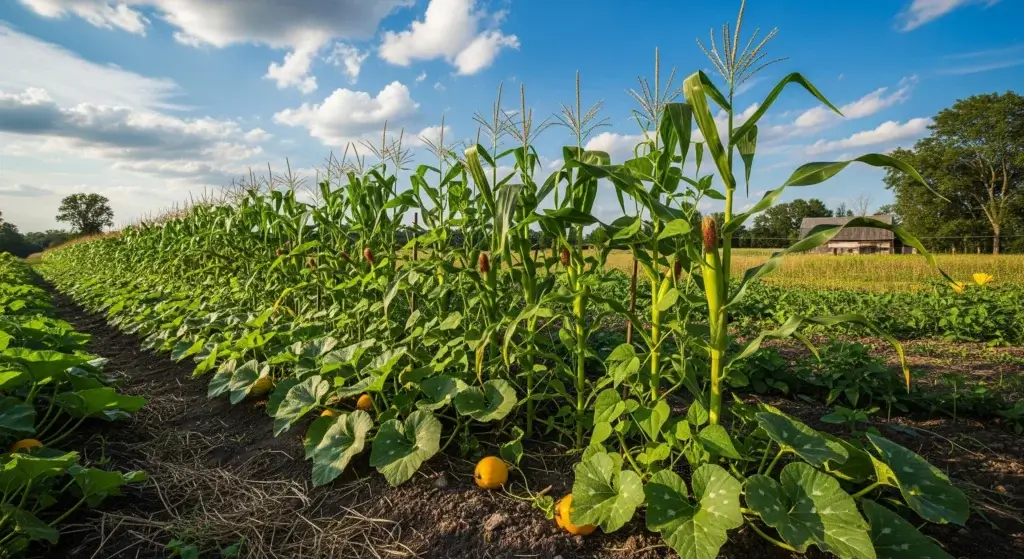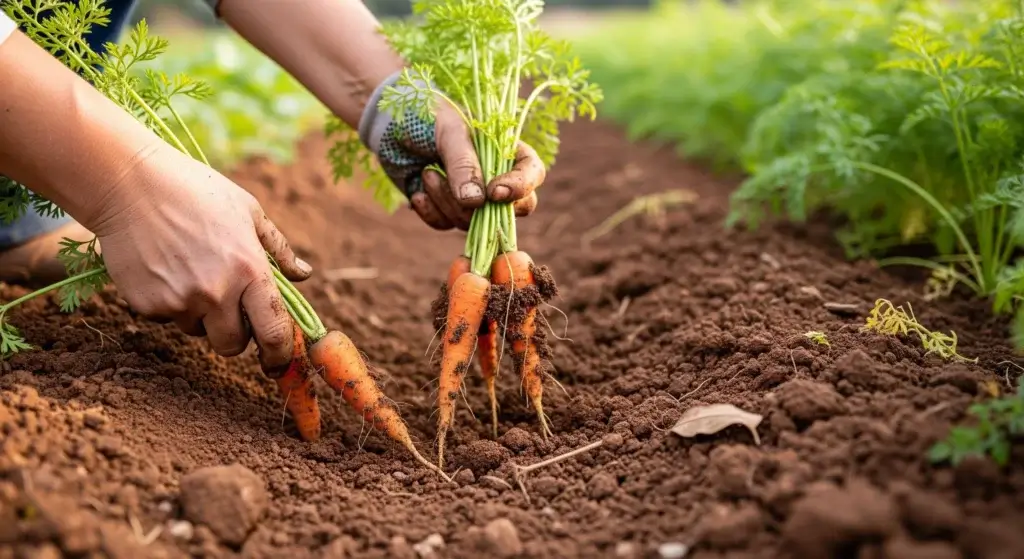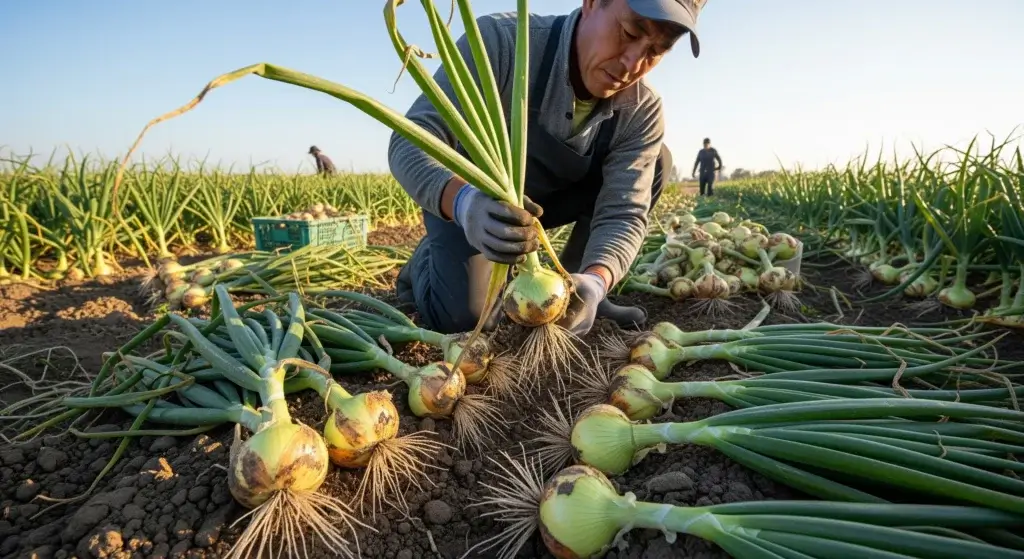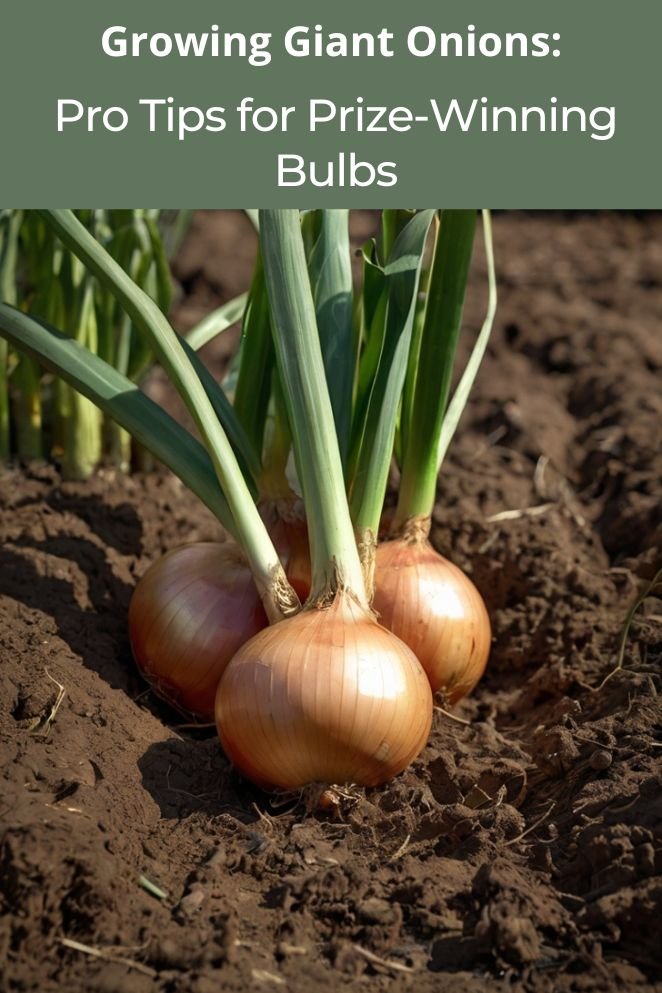
Ever seen those massive onions at fairs that look like they belong in a superhero origin story?
Yeah, those 10–15 lb. beasts aren’t freaks of nature—they’re the result of nerd-level gardening skills, the right seed, and some serious dedication.
Giant onions (yep, the world record is over 18 pounds!) aren’t just for bragging rights—they’re the ultimate flex in the gardening world.
And guess what? With the right variety, some know-how, and a little patience, you can grow one too.
Whether you’re chasing blue ribbons or just want your neighbors to do a double take, this is your guide to going full onion boss mode.
Understanding Giant Onion Varieties
If you’re dreaming of onions the size of bowling balls, you can’t just plant any old variety and hope for the best.
Nope—this is a choose-your-fighter situation, and picking the right one is your first power move.
Championship cultivars
Ailsa Craig
The GOAT of giant onions. Born in Scotland, this long-day legend is mild, massive, and the variety behind most show-stoppers at county fairs.
It stores well, tastes great, and has serious “look at me” energy.
Kelsae sweet giant
Think big, sweet, and kinda fancy. This one grows huge and tastes amazing.
Sweet enough to confuse your taste buds and big enough to earn a ribbon. Bonus: its cool flattened shape makes it stand out even more.
The Kelsae & Mammoth Red
These exhibition varieties are bred specifically to win.
They’re like the muscle cars of the onion world—built for size, structure, and flavor.
Perfect if you’re chasing that blue ribbon or just want to dominate your garden group chat.
- Read also: The No-Soil Solution: How to Grow Onion in Water
- Read also: Sprout Your Own: A Guide on How to Grow Onions from Seed
Day-length considerations
Onions are very particular about their daylight hours. Like, clock-watching particular.
- Long-day onions (14–16 hrs of sunlight): Ideal for northern regions. Think summer in Canada, the UK, or the northern U.S.—that’s when these giants bulk up.
- Short-day onions (10–12 hrs): Made for the South. If you’re in Texas or Florida, these are your people.
- Intermediate-day: The middle-ground onions—perfect for those awkward in-between zones where it’s not quite North, not quite South.
If you get the day length wrong, your onion won’t even try to bulb up.
It’ll just chill there like a confused houseplant.
So know your zone, pick the right variety, and let the giant-growing games begin.
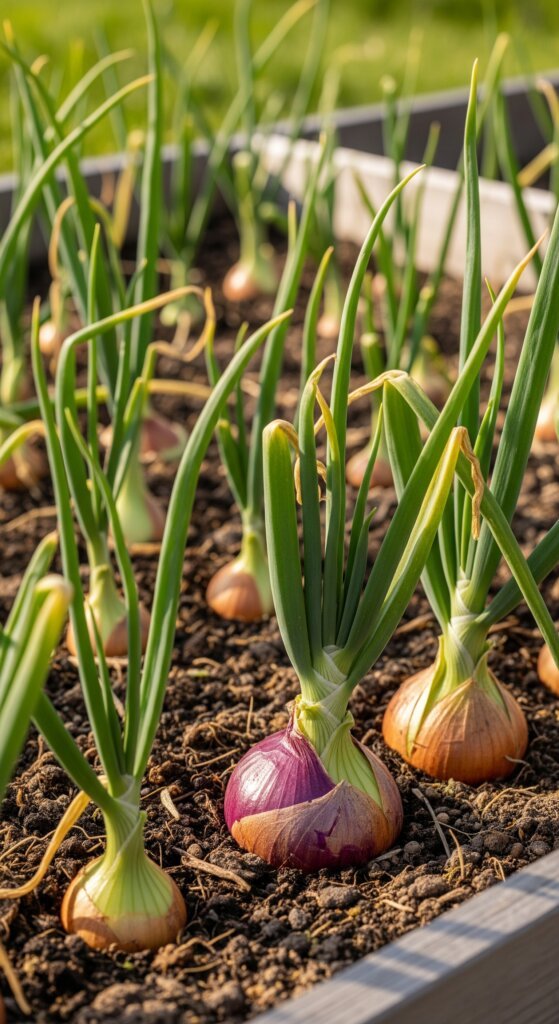
Soil Preparation: Building the Perfect Foundation
Wanna grow onions that look like they bench press carrots for fun? Then you need to give them five-star, spa-quality soil.
These giants won’t settle for sad, compacted dirt—they need luxury real estate for their roots. Let’s break it down.
Soil composition and pH
Your soil’s pH needs to be just right—between 6.0 and 7.0.
Not too acidic, not too alkaline.
Think of it as the pH sweet spot where your onions can actually absorb the buffet of nutrients you’re feeding them.
Pro move: Test your soil first. Guessing is for game shows, not giant onions.
Organic matter integration
These beasts need a rich buffet of composty goodness.
You want your beds to be about 25–30% organic matter—yes, that much.
Toss in stuff like:
- Well-aged cow or horse manure (nothing fresh—your onions aren’t into drama)
- Leaf mold (nature’s confetti)
- Veggie scraps from your kitchen compost
- Aged mushroom compost (fungi power!)
- Composted wood chips (only if they’ve aged like fine wine—2+ years)
This mix boosts water retention, improves structure, and feeds your onions all season long like a slow-cooker of nutrients.
Deep soil preparation
Giant onions don’t mess around underground.
Their roots want room to stretch, chill, and soak it all in.
You’ll need to dig or till at least 12–15 inches deep—think of it as creating a luxury basement apartment.
Break up compacted soil, boost drainage, and give those future monsters the space they need to thrive.
More air, more root room, more bulb boom.
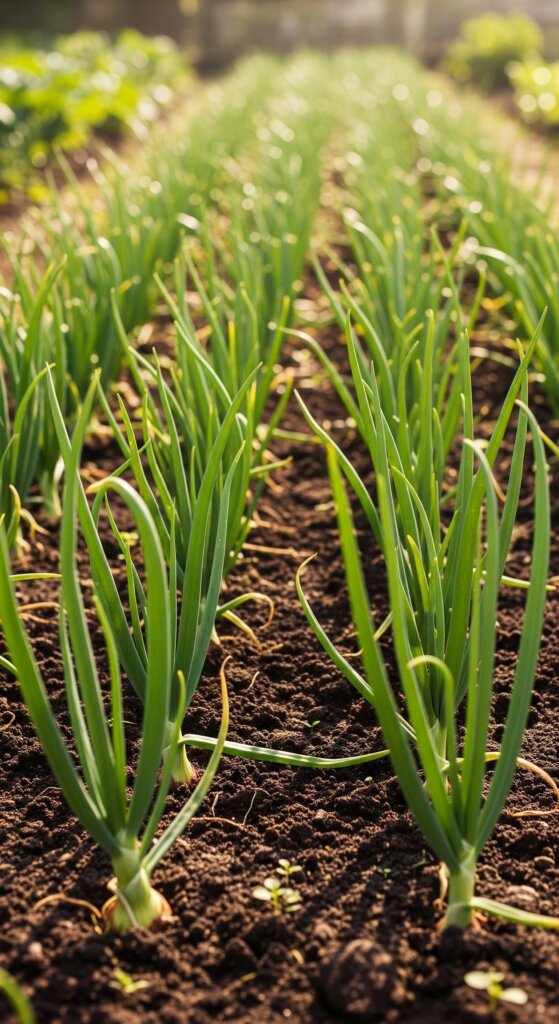
Strategic Planting Techniques
If you want onions that could double as bowling balls, you’ve gotta plant with purpose.
This isn’t your average “sprinkle and hope” situation—this is strategic warfare, and timing, spacing, and setup are your secret weapons.
Timing and transplant strategy
Want a head start? You need it.
Start seeds indoors about 10–12 weeks before your last frost.
Think of this as your onion’s training montage—early roots, strong starts, controlled environment.
Use a solid seed-starting mix in trays or small pots—none of that dollar-store dirt.
Spacing and layout optimization
Once soil temps hit 50°F consistently and your onions are standing tall with pencil-thick stems, it’s go time.
But don’t just toss them out into the wild.
Ease them into it with a 7–10 day hardening off period—kind of like giving them a Rocky-style cold shower to toughen up.
If you skip this step, you’re basically throwing your onions into a reality show with no warning. And they will freak out.
Advanced Nutrition Management
Fertilization strategies
Giant onions aren’t light eaters—they’re full-on nutrient junkies.
If you want those bulbs to bulk up like they’re training for the garden Olympics, you’ll need a strategic feeding plan.
Think of it like meal-prepping for gains: three phases, each with its own vibe. Let’s dig in.
Phase 1 – establishment (Weeks 1-6):
More leaves = more photosynthesis = bigger onions. So early on, go heavy on nitrogen to get that leafy growth booming.
Your go-to feed:
- NPK: 10-10-10 (balanced, classic starter)
- Apply liquid fertilizer weekly
- Think of this like the leafy green protein shake stage
Phase 2 – growth (Weeks 7-14):
Time to dial it up. Boost nitrogen but now give phosphorus some love too—your onions are in full lift-and-grow mode now.
Your go-to feed:
- NPK: 15-10-10 (nitrogen-heavy with a phosphorus punch)
- Feed granular bi-weekly, supplement with liquid snacks in between
- It’s like weightlifting AND eating six meals a day
Phase 3 – Bulb development (Weeks 15-20):
Now it’s time to switch gears. Cut back on nitrogen (no more leafy distractions), and pump up the potassium to size those bulbs and boost storage quality.
Your go-to feed:
- NPK: 5-10-15
- Focus on potassium like it’s the final boss
- You’re now feeding the onion equivalent of muscle recovery shakes
Organic feeding programs
If you’re keeping it crunchy and chemical-free, don’t worry—giant onions still love you. You just need a killer organic rotation:
- Fish emulsion – Early-stage nitrogen boost (smells weird, works wonders)
- Kelp meal – Micronutrients + bonus growth hormones = plant multivitamin
- Bone meal – Bring that phosphorus for root strength
- Wood ash – Use lightly mid-season for a potassium kick
Organic fertilizer schedule
- Monthly: Compost tea w/ kelp meal (hydration + micronutrients)
- Bi-weekly: Fish emulsion during growth phase (leafy fuel)
- Quarterly: Bone meal, scratched into the soil (root booster)
- Mid-season only: A sprinkle of wood ash for that bulb-thickening potassium boost
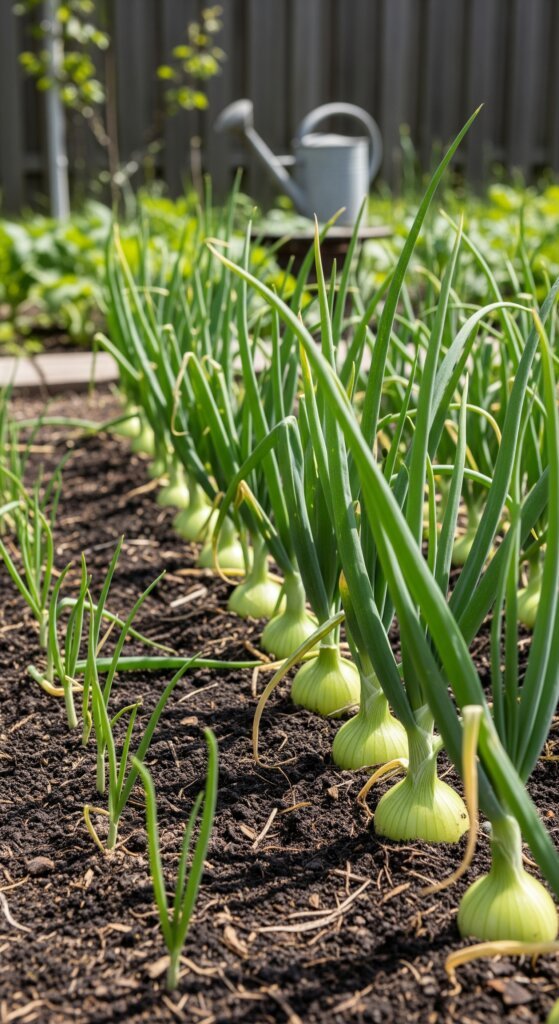
Water Management Excellence
If you want onions the size of softballs, don’t just guess when to water—treat it like an art form.
Giant onions are drama queens about moisture.
Too little? They sulk. Too much? They split like a boy band.
Let’s keep them steady, hydrated, and thriving.
Irrigation consistency
Your onions want regular moisture, not wild mood swings.
The secret? Even, steady watering—like a zen garden, not a flood zone.
- Shoot for 1 to 1.5 inches of water per week, rain included.
- Use drip irrigation or soaker hoses to keep the soil moist and the leaves dry. (Wet leaves = disease party)
- Stick your finger or a moisture meter in the soil about 4–6 inches deep. It should feel like a wrung-out sponge—damp, not soggy.
Critical watering periods
Your onions are going through their own little growth saga.
Water them like you’re following a carefully scripted trilogy.
Early season (Transplant to week 8):
- Frequent, light waterings
- Focus: get those roots cozy and established
- Think of it as baby bottle duty
Mid-season (Weeks 8–16):
- Deep, less frequent soaks
- Encourage deep root growth so they bulk up later
- This is the “lifting weights and eating protein” phase
Late season (Week 16 to Harvest):
- Start dialing back the water
- Less moisture helps bulbs mature, dry down, and store better
- It’s like carb-cutting before a bodybuilding show
Pest and Disease Prevention
Giant onions may look tough, but under all that size is a tender heart—vulnerable to a cast of creepy crawlies and microscopic menaces.
If you’re not careful, one bad pest can turn your blue-ribbon dreams into a mushy, moldy mess.
Let’s set up your onion fortress.
Common challenges
- Onion thrips – They suck the juice out of leaves, leaving a weird silver shimmer like your plant tried (and failed) a Y2K glitter trend. Less leaf power = smaller bulbs.
- Onion maggots – These sneaky tunnelers love chewing through your bulbs, turning them into rot magnets. They basically roll out the red carpet for fungus and bacteria.
- Fungal foes – Downy mildew, purple blotch, neck rot—these names sound like a villain team from a fantasy novel, and they’re just as destructive..
- Bacterial soft rot – One nick in your bulb, and this gooey chaos moves in fast. Think plant horror movie.
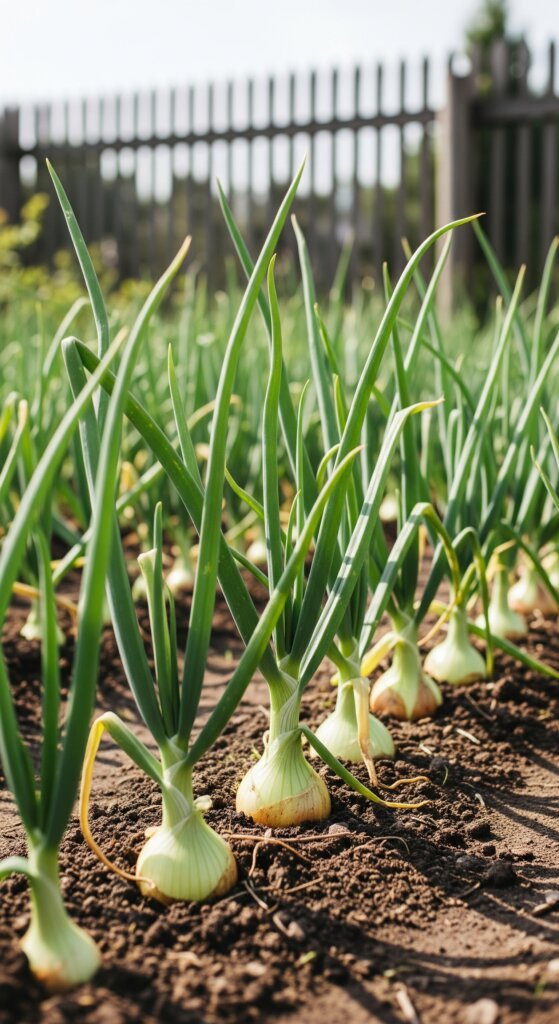
Integrated Management Strategies
You don’t need a ton of sprays and stress. You need a game plan.
Here’s how you play offense and defense:
1. Rotate
Never grow onions in the same spot two years in a row—three years is even better.
Why? Because pests and diseases love a predictable address. Mix it up to break their cycle.
2. Companion plants
Throw in carrots, lettuce, or herbs nearby.
They help confuse pests (yes, bugs get confused too), attract beneficial insects, and make better use of space.
Companion planting = natural pest control + garden feng shui.
3. Keep it clean
- Space your onions out like they’re introverts at a party—good airflow keeps leaves dry and reduces disease.
- Mulch up with straw or compost to block soil diseases from splashing up.
- Clean up plant debris like you’re Marie Kondo-ing your garden—no leftovers for overwintering pests.
4. Row covers & bug patrol
Pop on row covers early in the season to block flying insects before they even think about landing.
And encourage beneficial bugs like ladybugs and lacewings by planting flowers nearby. They’re your natural pest assassins.
- Read also: How to Grow Onion Bulbs: A Step-by-Step Guide for Harvests
- Read also: Top Strategies for Preventing Onion Downy Mildew
Conclusion: Your Path to Giant Onion Success
Growing giant onions isn’t just gardening—it’s part science, part art, and a whole lot of obsession (in the best way).
Yeah, it takes work: picking the right variety, prepping primo soil, feeding like a plant nutritionist, and staying on your watering game.
But once you get into the groove, it’s actually kinda addictive.
The best part? It’s not just about the size.
Along the way, you’ll learn skills that level up your entire garden—like soil health, timing, and pest management like a boss.
Whether you’re in it for the ribbons or just wanna shock your neighbors with a bulb the size of a newborn, it’s totally doable.

